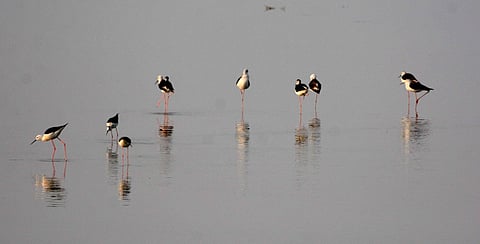

A total of 110,309 waterbirds of 110 species were recorded in a two-day census in the 307 square km Pong wetlands, one of the largest man-made wetlands in northern India, in Himachal Pradesh's Kangra district, it was announced on Wednesday.
Out of them, 100,018 of 59 species were migratory and 10,291 of 51 species resident. The total population of the flagship species, the bar-headed geese, one of world's highest-altitude fliers, stood at 47,598, an official statement said.
The other dominant species were the Eurasian coot (23,143), the northern pintail (4,665), the common teal (4,558), the common pochard (4,493), the Eurasian wigeon (4,149), the little cormorant (3,616), the northern shoveler (2,869), and the great cormorant (2,100).
The other uncommon species reported in the Pong wetlands are the greater white-fronted goose, the lesser white-fronted goose, the red-crested pochard, the ferruginous pochard, the pied avocet, the northern lapwing, the peregrine falcon, the common kestrel, the Eurasian hobby and the Eurasian spoonbill, smong others.
During the counting exercise from January 31 to February 1, one bar-headed goose with number marked as H74 was spotted.
The annual waterbird census was conducted under restrained conditions owing to Covid-19. The exercise was conducted by involving the field staff of the Hamirpur Wildlife Division of the wildlife wing. On January 29, the pre-census briefing was conducted online for the field staff regarding briefing and preparation of exercise.
On February 1, an exclusive estimation of larks and pipits was also carried out.
Eight species of larks and pipits were spotted. As per the estimation, among the larks and pipits, the sand lark was reported in the highest number (1,222), followed by the crested lark (331), the oriental skylark (265), the Eurasian skylark (231), the paddy field pipit (181), the tawny pipit (21), the Richard's pipit (six) and the rosy pipit (two).
Compared to 2021, the population of birds has increased from 108,578 to 110,309, while the number of species has increased from 96 to 110.
The most noticeable increase in the population of the bar-headed geese has shown an increase from 40,570 to 47,598 over the last year's count.
According to the Bombay Natural History Society (BNHS), the Pong wetlands are the one wintering grounds in the globe to hold such a large congregation of bar-headed geese.
Population of birds and number of species is expected to increase in coming days during return journey to their breeding grounds as birds from northwest, central, and south India will start arriving at the Pong wetlands.
Most of the wetlands in India have been regularly getting bar-headed geese every winter, but Pong holds the largest influx every winter, a BNHS ornithologist told IANS.
Most of these birds migrate from their breeding places in trans-Himalayan region in Tibet, Central Asia, Russia and Siberia. Over the last few years, the Pong Dam wetlands, a Ramsar site, has become an ideal destination for winter sojourn for many species of migratory birds.
Source : IANS